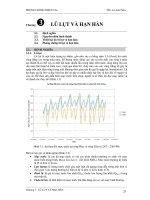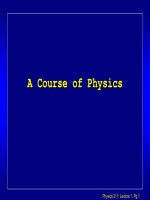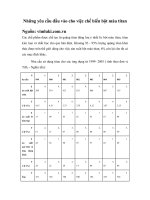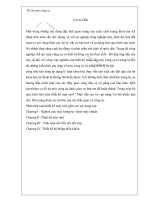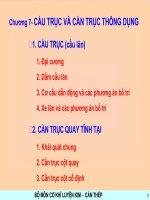Tài liệu 37 Time-Varying Analysis-Synthesis Filter Banks docx
Bạn đang xem bản rút gọn của tài liệu. Xem và tải ngay bản đầy đủ của tài liệu tại đây (170.35 KB, 14 trang )
Iraj Sodagar. “Time-Varying Analysis-Synthesis Filter Banks”
2000 CRC Press LLC. <>.
Time-VaryingAnalysis-Synthesis
FilterBanks
IrajSodagar
DavidSarnoffResearchCenter
37.1Introduction
37.2AnalysisofTime-VaryingFilterBanks
37.3DirectSwitchingofFilterBanks
37.4Time-VaryingFilterBankDesignTechniques
ApproachI:IntermediateAnalysis-Synthesis(IAS)
•
Approach
II:InstantaneousTransformSwitching(ITS)
37.5Conclusion
References
37.1 Introduction
Time-frequencyrepresentations(TFR)combinethetime-domainandfrequency-domainrepresen-
tationsintoasingleframeworktoobtainthenotionoftime-frequency.TFRofferthetimelocalization
vs.frequencylocalizationtradeoffbetweentwoextremecasesoftime-domainandfrequency-domain
representations.Theshort-timeFouriertransform(STFT)[1,2,3,4,5]andtheGabortransform[6]
aretheclassicalexamplesoflineartime-frequencytransformswhichusetime-shiftedandfrequency-
shiftedbasisfunctions.
Inconventionaltime-frequencytransforms,theunderlyingbasisfunctionsarefixedintimeand
defineaspecifictilingofthetime-frequencyplane.Thetermtime-frequencytileofaparticular
basisfunctionismeanttodesignatetheregionintheplanethatcontainsmostofthatfunction’s
energy.Theshort-timeFouriertransformandthewavelettransformarejusttwoofmanypossible
tilingsofthetime-frequencyplane.ThesetwoareillustratedinFig.37.1(a)and(b),respectively.In
thesefigures,therectangularrepresentationforatileispurelysymbolic,sincenofunctioncanhave
compactsupportinbothtimeandfrequency.Otherarbitrarytilingsofthetime-frequencyplaneare
possiblesuchastheexampleshowninFig.37.1(c).Inthediscretedomain,lineartime-frequency
transformscanbeimplementedintheformoffilterbankstructures.
Itiswellknownthatthetime-frequencyenergydistributionofsignalsoftenchangeswithtime.
Thus,inthissense,theconventionallineartime-frequencytransformparadigmisfundamentally
mismatchedtomanysignalsofinterest.Amoreflexibleandaccurateapproachisobtainedifthe
basisfunctionsofthetransformareallowedtoadapttothesignalproperties.Anexampleofsuch
atime-varyingtilingisshowninFigure37.1(d).Inthisscenario,thetime-frequencytilingofthe
transformcanbechangedfromgoodfrequencylocalizationtogoodtimelocalizationandviceversa.
Time-varyingfilterbanksprovidesuchflexibleandadaptivetime-frequencytilings.
c
1999byCRCPressLLC
FIGURE 37.1: The time-frequency tiling for differenttime-frequency transforms: (a) The STFT,(b)
thewavelettransform,(c)anexampleofgeneraltiling,and(d)anexampleofthetime-varyingtiling.
The concept of time varying (or adaptive) filter banks was originally introduced in [7]byNayebi
et al. The ideas underlying their method were later developed and extended to a more general case
in which it was also shown that the number of frequency bands could also be made adaptive [8, 9,
10, 11]. De Queiroz and Rao [12] reported time-varying extended lapped transforms and Herley et
al. [13, 14, 15] introduced another time-domain approach for designing time-varying lossless filter
banks. Arrowood and Smith [16] demonstrated a method for switching between filter banks using
latticestructures. In[17], the authors presentedyet another formulation for designing time-varying
filterbanksusingadifferentfactorizationoftheparaunitarytransform. ChenandVaidyanathan[18]
reported a noncausal approach to time-varying filter banks by using time-reversed filters. Phoong
and Vaidyanathan [19] studied time-varying paraunitary filter banks using polyphase approach.
In [11, 20, 21, 22], the post filtering technique for designing time-varying filter bank was reported.
The design of multidimensional time-varying filter bank was addressed in [23, 24]. In this article,
we introduce the notion of the time-varying filter banks and briefly discuss some design methods.
37.2 Analysis of Time-Varying Filter Banks
Time-varying filter banks are analysis-synthesis systems in which the analysis filters, the synthesis
filters,thenumberofbands,thedecimationrates,andthefrequencycoverageofthebandsarechanged
(in part or in total) in time, as is shown in Fig. 37.2. By carefully adapting the analysis section to
the temporal properties of the input signal, better performance can be achieved in processing the
signal. Intheabsenceofprocessingerrors,thereconstructedoutput ˆx(n) shouldcloselyapproximate
a delayed version of the original signal x(n). When ˆx(n − ) = x(n) for some integer constant, ,
then we say that the filter bank is perfectly reconstructing (PR). The intent of the design is to choose
the time-varying analysis andsynthesisfiltersalongwith thetime-vary ing down/up samplers so that
the system requirements are met subject to the constraint that the analysis-synthesis filter bank be
PR at all times.
c
1999 by CRC Press LLC
FIGURE 37.2: The time-varying filter bank structure with time-vary ing filters and time-dependent
down/up samplers.
One general method for analysis of time-varying filter banks is the time-domain formulation
reported in [10, 22]. In this method, the time-varying impulse response of the entire filter bank is
derived in terms of the analysis and synthesis filter coefficients.
Figure (37.3) shows the diagram of a time-vary ing filter bank. In this figure, the filter bank is
divided into three stages: the analysis filters, the down/up samplers, and the synthesis filters. The
signals x(n) and ˆx(n) are the filter bank input and output at time n, respectively. The outputs
of the analysis filters are shown by v(n) =[v
0
(n), v
1
(n), ,v
M(n)−1
(n)]
T
,wherev
i
(n) is the
output of the ith analysis filter at time n. The outputs of the down/up samplers at time n is called
w(n) =[w
0
(n), w
1
(n), ,w
M(n)−1
(n)]
T
.
FIGURE 37.3: Time-varying filter bank as a cascade of analysis filters, down/up samplers, and
synthesis filters.
The input/output relation of the analysis filters can be expressed by
v(n) = P(n)x
N
(n) . (37.1)
P(n) is an M(n) × N(n) matrix whose mth row is comprised of the coefficients of the mth analysis
filter at time n and x
N
(n) is the input vector of length N (n) at time n:
x
N
(n) =[x(n), x(n − 1), x(n − 2), ,x(n− N(n) + 1)]
T
. (37.2)
The input/output function of down/up samplers can be expressed in the form
w(n) = (n)v(n)
(37.3)
where (n) is a diagonal matrix of size M(n) × M(n).Themth diagonal element of (n), at time
n,is1 if the input and output of the mth down/up sampler are identical, otherwise it is zero.
c
1999 by CRC Press LLC
To write the input/output relationship of the synthesis filters, Q(n) is defined as
Q(n) =
g
0
(n, 0)g
0
(n, 1)g
0
(n, 2) g
0
(n, N(n) − 1)
g
1
(n, 0)g
1
(n, 1)g
1
(n, 2) g
1
(n, N(n) − 1)
g
2
(n, 0)g
2
(n, 1)g
2
(n, 2) g
2
(n, N(n) − 1)
.
.
.
.
.
.
.
.
.
.
.
.
.
.
.
g
M(n)−1
(n, 0)g
M(n)−1
(n, 1)g
M(n)−1
(n, 2) g
M(n)−1
(n, N(n) − 1)
=
q
0
(n) q
1
(n) q
2
(n) . . . q
N(n)−1
(n)
(37.4)
where q
i
(n) =[g
0
(n, i), g
1
(n, i), g
2
(n,i), ,g
M(n)−1
(n, i)]
T
, is a vector of length M(n) and
g
i
(n, j) denotes the j th coefficient of the ith synthesis filter. At time n, the mth synthesis filter
is convolved with vector [w
m
(n), w
m
(n − 1), ,w
m
(n − N (n) + 1)]
T
and all outputs are added
together. UsingEq. (37.4), the output of the filter bank at time n can be written as:
ˆx(n) =
N(n)−1
i=0
q
T
i
(n) w(n − i) . (37.5)
If s(n) and ˆw(n) are defined as
s(n) =
q
T
0
(n), q
T
1
(n), q
T
2
, ,q
T
N(n)−1
(n)
T
(37.6)
ˆw(n) =
w
T
(n), w
T
(n − 1), w
T
(n − 2), ,w
T
(n − N(n) + 1)
T
, (37.7)
then Eq. (37.5) can be wr itten in the for m of one inner product,
ˆx(n) = s
T
(n) ˆw(n) (37.8)
where s(n) and ˆw(n) are vectors of length N(n)M(n). Using Eqs. (37.1), (37.3), (37.7), and (37.8),
the input/output function of the filter bank can be written as:
ˆx(n) = s
T
(n)
(n) P(n) x
N
(n)
(n − 1) P(n − 1) x
N
(n − 1)
(n − 2) P(n − 2) x
N
(n − 2)
.
.
.
(n − N(n) + 1) P(n − N (n) + 1) x
N
(n − N(n) + 1)
.
(37.9)
As the last N(n) − 1 elements of vector x
N
(n − i) are identical to the first N(n) − 1 elements of
vector x
N
(n − i − 1), the latter equation can be expressed by
ˆx(n) = s
T
(n)
(n) P(n)
O O
O
(n − 1) P(n − 1)
O O
OO
(n − 2) P(n − 2)
O O
.
.
.
O O
(n − N (n) + 1) P(n − N(n) + 1)
x(n)
x(n − 1)
x(n − 2)
.
.
.
x(n − 2N (n) + 1)
(37.10)
c
1999 by CRC Press LLC
where O is the zero column vector with length M(n). Thus, the input/output function of a time-
varying filter bank can be expressed in the form of
ˆx(n) = z
T
(n)x
I
(n) (37.11)
where x
I
(n) =[x(n), x(n − 1), ,x(n− I + 1)]
T
and I (n) = 2N(n) − 1 and z(n) is the time-
varying impulse response vector of the filter bank at time n:
z(n) = A(n) s(n).
(37.12)
The matrix A(n) is the [2N (n) − 1]×[N(n) M(n)] matrix
A(n) =
P(n)
T
(n)
O
T
O
T
.
.
.
O
T
O
T
P(n − 1)
T
(n − 1)
O
T
.
.
.
O
T
.
.
.
O
T
.
.
.
O
T
P(n − N (n) + 1)
T
(n − N (n) + 1)
.
(37.13)
Forap erfectreconstructionfilterbankwithadelayof,itisnecessaryandsufficientthatallelements
but the ( + 1)th in z(n) be equal to zeroat all times. The ( + 1)th entry of z(n) must be equal to
one. If the ideal impulse response is b(n), the filter bank is PR if and only if
A(n) s(n) = b(n) for all n.
(37.14)
37.3 Direct Switching of Filter Banks
Changingfromone arbitraryfilterbank toanotherindependently designedfilterbankwithout using
any intermediate filters is called direct switching. D irect switching is the simplest switching scheme
and does not require additional steps in switching between two filter banks. But such switching
will result in a substantial amount of reconstruction distortion during the transition period. This is
becauseduringthetransition,noneofthesynthesisfilterssatisfiestheexactreconstructionconditions.
Figure(37.4)showsanexampleofadirectswitchingfilterbank. Figure(37.5)showsthetime-varying
impulse response of the above system around the transition periods. In this figure, z(n, m) is the
response of the system at time n to the unit input at time m.ForaPRsystem,z(n, m) hasaheight
of 1 along the diagonal and 0 everywhere else in the (m, n)-plane. As is shown, the time-varying
filter bank is PR before and after but not during the transition periods. In this case, each switching
operation generates a distortion with an 8-sample duration. One way to reduce the distortion is to
switchthesynthesisfilters with anappropriatedelaywithrespecttotheanalysis switchingtime. This
delay may reduce the output distortion, but it can not eliminate it.
37.4 Time-Varying Filter Bank Design Techniques
The basic time-varying filter bank design methods are summarized in Table 37.1. These techniques
can be divided into two major approaches which are briefly described in the following sections.
c
1999 by CRC Press LLC
FIGURE 37.4: Block diagram of a time-varying analysis/synthesis filter bank that switches between
a two- and three-band decomposition.
TABLE37.1 Comparison of Time-Varying Filter Bank Different Designing Methods
Intermediate Changing freq. Filter bank Computational
analysis resolution requirement complexity
Arrowood Lattice
Smith Yes Indirect structures Low
de Queiroz
Rao Yes Indirect ELT Low
Intermediate Gopinath
analysis Burrus Yes Indirect Paraunitary Low
synthesis Herley et. al Yes Direct Paraunitary Low
(IAS) Chen Noncausal
Vaidyanathan Yes Direct synthesis Low
Least square General
Instantaneous synthesis No Direct (not PR) Low
transform Redesigning
switching analysis No Direct General High
(ITS) Post
filtering No Direct General Low
37.4.1 Approach I: Intermediate Analysis-Synthesis (IAS)
In the first approach, both analysis and synthesis filters are allowed to change during the transition
period to maintain perfect reconstruction. We refer to this approach as the intermediate analysis-
synthesis (IAS) approach.
In [16], the authors have chosen to start with the lattice implementation of time-invariant two-
band filter banks, originally proposed by Vaidyanathan [25] for time-invariant case. Consider the
latticestructureshowninFig.37.6. Figure37.6(a)representsalossless two-band analysisfilterbank,
consistingofJ + 1 latticestages. ThecorrespondingsynthesisfilterbankisshowninFig.37.6(b). As
is shown, for each stage in the analysis filter bank, there exists a corresponding stage in the synthesis
filter bank with similar, but inversefunctionality. As long as each twocorrespondinglattice stages in
theanalysisandsynthesissectionsarePR,theoverallsystemisPR.Toswitchonefilterbanktoanother,
the lattice stages of the analysis section are changed from one set to another. If the corresponding
latticestagesofthesynthesis sectionarealsochangedaccordingtothe changesoftheanalysissection,
thePRpropertywillholdduringtransition. Duetotheexistenceofdelayelements,anychangeinthe
analysis section must be followed with the corresponding change in the synthesis section, but with
an appropriate delay. For example, the parameter α
j
of the analysis and synthesis filter banks can
c
1999 by CRC Press LLC
FIGURE 37.5: The time-vary ing impulse response for direct switching between the two- and the
three-band system. The filter bank is switched from the two-band to the three-band at time n = 0
and switched back at time n = 13. (a) Surface plot, (b) contour plot.
be changed instantaneously. But any change in parameter α
j−1
in the analysis filter bank must be
followed with the similar change in the synthesis filter bank after one sample delay. Because of such
delays,switchingbetween twoPRfilter bankscanoccur onlybygoingthrough atransition period in
which both analysis and synthesis filter banks are changing in time.
In [12, 26], the design of time-varying extended lapped transform (ELT) [27, 28] was reported.
The extended lapped transform is a cosine-modulated filter bank with an additional constraint on
thefilterlengths. Here,thedesignprocedureisbasedon factorizationofthetime-domain transform
matrix into permutation and rotation matrices. As the ELT is paraunitary, the inverse transform
can be obtained byreversingtheorder ofthematrix multiplication. Sinceanyorthogonal transform
is a succession of plane rotations, any changes in these rotation angles result in changing the filter
bank without losing the orthogonality property. The authors derived a general frame work for M-
band ELT transforms compared to the two-band case approach in [16]. This method parallels the
lattice technique[16]exceptwith the mild modification of imposing the additional ELT constraints.
In [17], the authors presented yet another formulation for designing time-varying filter banks. In
this paper, a different factorization of the paraunitary transform has been shown which is not based
on plane rotations unlike the ones in [12, 26]. Using this factorization, a paraunitary filter bank
can be implemented in the form of some cascade structures. Again, to switch one filter bank to
c
1999 by CRC Press LLC
FIGURE 37.6: The block diagram of a two-band paraunitary filter bank in lattice form: (a) analysis
lattice, (b) synthesis lattice.
another, the corresponding structures in the analysis and synthesis filter bank are changed similarly
but with an appropriate delay. If the orthogonality property in each cascade structure ismaintained,
the time-varying filter bank remains PR. This formulation is very similar to the ones in [12, 16, 26],
but represent a more general form of factorization. In fact, all above procedures consider similar
frameworks of structures that inherently guarantee the exact reconstruction.
Herley et al. [ 13, 14, 15, 29] introduced a time-domain method for designing time-varying pa-
raunitary filter banks. In this approach, the time-invariant analysis transforms do not overlap. As a
simple example, consider the case of switching between two paraunitary time-invariant filter banks.
The analysis transform around the transition period can be written as
T =
P
1
P
T
P
2
.
(37.15)
The matrices P
1
and P
2
represent paraunitray transforms and therefore are unitary matrices. Their
nonzero columns also do not overlap with each other. The matrix P
T
represents the analysis filter
bank during the transition period. In order tofindthisfilterbank,thematrix P
T
is initially replaced
with a zero matrix. Then, the null space of the transform T is found. Any matrix that spans this
subspace can be a candidate vector for P
T
. By choosing enough independent vectors of this null
space and applying the Gram-Schimidt proceduretothem, an orthogonal transform can be selected
for P
T
. This method has also been applied to time-varying modulated lapped transforms [24] and
two-dimensional time-varying paraunitary filter banks [30].
The basic property of all above procedures is the use of intermediate analysis transforms in the
transitionperiod. Thecharacteristicsoftheseanalysistransformsarenoteasytocontrolandtypically
the intermediate filters are not well-behaved.
c
1999 by CRC Press LLC
37.4.2 Approach II: Instantaneous Transform Switching (ITS)
In the second approach, the analysis filters are switched instantaneously and time-varying synthesis
filters are used in the transition period. We refer to this approach as the instantaneous transform
switching (ITS) approach. In the ITS approach, the analysis filter bank may be switched to another
setofanalysisfiltersarbitrarily. Thismeansthatthebasisvectorsandthe tilingofthetime-frequency
plane can be changed instantaneously. To achieve PR at each time in the transition period, a new
synthesis section is designed to ensure proper reconstruction.
Intheleastsquares(LS)method[10],foranygivensetofanalysisfilters,aLSsolutionofEq.(37.14)
can be used to obtain the “best” synthesis filters of the corresponding system (in L2 norm):
s
(
n
)
LS
=
A
(
n
)
T
A(n)
−1
A
(
n
)
T
b(n) (37.16)
The advantageoftheLSapproach isthatthere isnolimitationonthenumberofanalysisfilterbanks
that can be used in the system. The disadvantage of the LS method is that it does not achieve PR.
However, experiments have shown that the reconstruction is significantly improved in this method
compared to direct switching [10].
In the LS solution, b(n) is projected onto the column space of A(n). For PR, the projection error
should be zero. Thus, to obtain time-varying PR filter banks, the reconstruction error,||A(n)s(n) −
b(n)||
2
, can be brought to zero with an optimization procedure. The optimization operates on the
analysis filtercoefficients and modifiestherangespaceofA(n) until b(n) ∈ range(A(n)). Although
the s(n)’s at different states are independent of each other, since the A(n)’s have some common
elements, optimization procedures should be applied to all analysis sections at the same time. This
method is referred to as “redesigning analysis” [10].
The last ITS method, post filtering, uses conventional filter banks with time-varying coefficients
followedbyatime-varying postfilter. The post filterprovides exactreconstructionduring transition
periods, while it operates as a constant delay elsewhere. Assume at time n
0
the time-varying filter
bank is switched from the first filter bank to the second. If the length of the transition period is L
samples,theoutputofthefilterbankintheinterval[n
0
,n
0
+L− 1] isdistortedb ecauseofswitching.
The post filter removes this distortion. The block diag ram of such a system is shown in Fig. (37.7).
In this figure, z(n) and y(n) are the analysis/synthesis filter bank and post filter impulse responses,
FIGURE 37.7: The block diagram of time-varying filter bank and post filter.
respectively. If the delays of the filter bank and the post filter are denoted and ,respectively,we
can write
ˆx(n) =
Distorted if n
0
≤ n<n
0
+ L
x(n − ) otherwise .
(37.17)
The desired output of the post filter is
˜x(n) = x(n − − )
(37.18)
c
1999 by CRC Press LLC
Theinput/outputrelationofthetime-varying filterbankduringthetransitionperiod canbewritten
as
ˆx(n) = z
T
(n) x
I
(n) (37.19)
where x
I
(n) is the input vector at time n:
x
I
(n) =
[
x(n), x(n − 1), x(n − 2), ,x(n− I + 1)
]
T
.
z(n) isa vectoroflengthI andrepresentsthetime-varyingimpulseresponseofthefilterbankattime
n. If the transition impulse response matrix is defined to be
Z=
z(n
0
+ L − 1)
O
O
.
.
.
O
O
z(n
0
+ L − 2)
O
.
.
.
O
.
.
.
O
O
.
.
.
O
z(n
0
)
,
(37.20)
then the input/output relation of the filter bank in the transition period can be described as
ˆx
L
(n
0
+ L − 1) = Z
T
x
K
(n
0
+ L − 1) (37.21)
where Z is a K × L matrix and K = I + L − 1. In Eq. (37.21), the I − − 1 samples before and
samples after the transition period are used to evaluate the output. The above intervals are called
the tail and head of the transition period, respectively. Sincethe first and second filter banks are PR,
the tail and head samples are exactly reconstructed. We write x
K
(n
0
+ L − 1) as the concatenation
of three vectors:
x
K
(n
0
+ L − 1) =
x
a
x
t
x
b
,
(37.22)
wherex
a
andx
b
aretheinputsignalsintheheadandtailregionswhilex
t
representstheinputsamples
which are distorted during the transition period. Using this notation, Eq. (37.21) can be written as
ˆx
L
(n
0
+ L − 1) = Z
T
a
x
a
+ Z
T
t
x
t
+ Z
T
b
x
b
(37.23)
where
Z =
Z
a
Z
t
Z
b
.
(37.24)
By replacing vectors x
b
and x
a
with their corresponding output vectors ˆx
a
and ˆx
b
, x
t
of Eq. (37.23)
can be written as
x
t
= (Z
T
t
)
−1
(ˆx
t
− Z
T
a
ˆx
a
− Z
T
b
ˆx
b
)
= Y
T
ˆx
K
. (37.25)
Equation (37.25) describes the post filter input-output relationship during the transition region. In
this equation, Y is the time-varying post filter impulse response which is defined as
Y =
−Z
a
Z
−1
t
Z
−1
t
−Z
b
Z
−1
t
.
(37.26)
From Eq. (37.25), it is obvious that the condition for causal post filtering is
≥ L + − 1 .
(37.27)
c
1999 by CRC Press LLC
The post filter exists if Z
t
has an inverse. It can be shown that the transition response matrix Z
t
,
can be described by a matrix, product of the form
Z
t
=
L
S (37.28)
where
L
is the analysis transform applied to those input samples that are distorted during the
transition period and S contains the synthesis filters during the transition period. In order for Z
t
to
be invertible, it is necessary (but not sufficient) that
L
and S be full rank matr ices. The analysis
sections are defined by the required properties of the first and second filter banks and
L
is fixed.
Therefore, a filter bank is switchable to another filter bank if the corresponding
L
is a full rank
matrix. In this case, by proper design of the synthesis section, both S and Z
t
will be full rank. Two
methods to obtain proper synthesis filters are shown in [20, 22].
37.5 Conclusion
In this article, we briefly review some analysis and design methods of time-vary ing filter banks.
Time-varying filter banks can provide a more flexible and accurate approach in which the basis
functions of the time-frequency transform are allowed to adapt to the signal properties.
Asimpleformoftime-varyingfilterbankisachievedbychangingthefiltersofananalysis-synthesis
system among a number of choices. Even if all the analysis and synthesis filters are PR sets, exact
reconstructionwillnotnormallybeachievedduringthetransitionperiods. Toeliminatealldistortion
during a transition period, new time-varying analysis and/or synthesis sections are required for the
transition periods.
Two different approaches for the design were discussed here. In the first approach, both analysis
and synthesis filters are allowed to change during the transition period to maintain PR and so it is
calledtheintermediateanalysis-synthesis(IAS)approach. Inthesecondapproach,theanalysisfilters
areswitchedinstantaneouslyandtime-varyingsynthesisfiltersareusedinthetransitionperiod. This
approach is know n as the instantaneous transform switching (ITS) approach.
In the IAS approach, both analysis and synthesis filters can change during the t ransitions rather
than onlythesynthesisfiltersinITSapproach. That impliesthatmaintainingPRconditions iseasier
intheIASapproach. Notethattheanalysisfiltersinthetransition periodsaredesignedonlytosatisfy
PR conditions and they do not usually meet the desired time and frequency characteristics.
In the ITS approach, only synthesis filters are allowed to be time-varying in the transition peri-
ods. These methods have the advantage of providing instantaneous switching between the analysis
transforms compared to IAS methods. But they have different drawbacks: the LS method does not
satisfyPRconditionsatalltimes, theredesigninganalysismethodrequiresjointlyoptimizationofthe
time-invariant analysis section, and finally the post filtering method has the drawback of additional
computational complexity required for post filtering.
The analysis and design methods of the time-varying filter bank have been developed to desig n
adaptive time-frequencytransforms. Theseadaptivetransformshavemanypotentialapplicationsin
areassuchastime-frequencyrepresentation,subbandimageandvideocoding,andspeechandaudio
coding. Butsincethedevelopmentsofthetime-varyingfilterbanktheoryisverynew,itsapplications
have not been investigated yet.
References
[1] Allen, J.B., Short-term spectral analysis, synthesis, and modification by discrete fourier trans-
form,
IEEE Trans. Acoustics, Speech, Signal Processing, 25, 235–238, June 1977.
[2] Allen, J.B. and Rabiner, L.R., A unified approach to STFT analysis and synthesis,
Proc. IEEE,
65, 1558–1564, Nov.1977.
c
1999 by CRC Press LLC
[3] Rabiner,L.R.andSchafer,R.W.,Digital ProcessingofSpeechSignals,Prentice-Hall,Englewood
Cliffs, NJ, 1978.
[4] Portnoff, M.R., Time-frequency representation of digital signals and systems based on short-
time fourier analysis,
IEEE Trans. Acoustics, Speech, Signal Processing, 55–69, Feb. 1980.
[5] Nawab, S.N. and Quatieri, T.F.,
Short-Time Fourier Transform, Chapter in Advanced Topics
in Signal Processing,
Prentice-Hall, Eng lewood Cliffs, NJ, 1988.
[6] Gabor, D.,Theory of communication,
J. IEE (London), 93(III), 429–457, Nov. 1946.
[7] Nayebi, K., Barnwell, T.P., and Smith, M.J.T., Analysis-synthesis systems with time-varying
filter bank structures,
Proc. Intl. Conf. Acoustics, Speech, Signal Processing, Mar. 1991.
[8] Nayebi,K.,Sodagar,I., andBarnwell,T.P.,Thewavelettransformandtime-varyingtilingofthe
time-frequency plane,
IEEE-SP Intl. Symp. Time-Frequency and Time-Scale Analysis, Oct.
1992.
[9] Sodagar, I., Nayebi, K., and Barnwell, T.P., A class of time-varying wavelet transforms,
Proc.
Intl. Conf. Acoustics, Speech, Sig nal Processing,
April 1993.
[10] Sodagar,I.,Nayebi,K.,Barnwell,T.P.,andSmith,M.J.T.,Time-varyingfilterbanksandwavelets,
IEEE Trans. Signal Processing, Nov.1994.
[11] Sodagar, I., Analysis and Design of Time-Varying Filter Banks, Ph.D. thesis, Georgia Institute
of Technology, Atlanta, GA, Dec. 1994.
[12] de Queiroz, R.L.andRao, K.R.,Adaptiveextendedlappedtransforms,
Proc. Intl. Conf. Acous-
tics, Speech, Signal Processing,
April 1993.
[13] Herley,C.,Kovacevic,J.,Ramchandran,K.,andVetterli,M.,Arbitr ary orthogonaltilingsofthe
time-frequency plane,
IEEE-SP Intl. Symp. Time-Frequency and Time-Scale Analysis, Oct.
1992.
[14] Herley,C.andVetterli,M.,Orthogonaltime-varyingfilterbanksandwavelets,
Proc.Intl.Symp.
Circuits Syst.,
Apr.1993.
[15] Herley,C.,Wavelets and Filter Banks, Ph.D. thesis, Columbia University, New York, 1993.
[16] Arrowood, J.L. and Smith, M.J.T., Exact reconstruction analysis/synthesis filter banks with
time-var ying filters,
Proc. Intl. Conf. Acoustics, Speech, Signal Processing, Apr. 1993.
[17] Gopinath, R.A., Factorization approach to time-varying filter banks and wavelets,
Proc. Intl.
Conf. Acoustics, Speech, Signal Processing,
Apr.1994.
[18] Chen, T. and Vaidyanathan, P.P., Time-reversed inversion for time-varying filter banks,
Proc.
27th Asilomar Conf. on Signals, Systems, and Computers,
1993.
[19] Phoong,S.andVaidyanathan,P.P.,Onthestudyoflosslesstime-varyingfilterbanks,
Proc.29th
Asilomar Conf. on Signals, Systems, and Computers,
1995.
[20] Sodagar, I., Nayebi, K., Barnwell, T.P., and Smith, M.J.T., A new approach to time-varying FIR
filter banks,
Proc. 27th Asilomar Conf. on Signals, Systems, and Computers, 1993.
[21] Sodagar, I., Nayebi, K., Barnwell, T.P., and Smith, M.J.T., A novel structure for time-varying
FIR filter banks,
Proc. Intl. Conf. Acoustics, Speech, and Signal Processing, 1994.
[22] Sodagar, I., Nayebi, K., and Barnwell, T.P., Time-varying analysis-synthesis systems based on
filter banks and post filtering,
IEEE Trans. Signal Processing, Oct. 1995.
[23] Sodagar, I., Nayebi, K., Barnwell, T.P., and Smith, M.J.T., Perfect reconstruction multidimen-
sional filter banks with time-varying basis functions,
Proc. 27th Asilomar Conf. on Signals,
Systems, and Computers,
1993.
[24] Kovacevic,J.andVetterli,M.,Time-varyingmodulatedlappedtransforms,
Proc.27thAsilomar
Conf. on Signals, Systems, and Computers,
1993.
[25] Vaidyanathan, P.P., Theory and design of M channel maximally decimated QMF with arbi-
trary M, having perfect reconstruction property,
IEEE Trans. Acoustics, Speech, and Signal
Processing,
Apr.1987.
[26] de Queiroz, R.L. and Rao, K.R., Time-varying lapped transforms and wavelet packets,
IEEE
Trans. Signal Processing,
3293–3305, Dec. 1993.
c
1999 by CRC Press LLC
[27] Malvar, H.S. and Staelin, D.H., The LOT: Transform coding without blocking effects, IEEE
Trans. Acoustics, Speech, and Sig nal Processing,
553–559, Apr.1989.
[28] Malvar, H.S., The lapped transforms for efficient transform/subband coding,
IEEE Trans.
Acoustics, Speech, and Signal Processing,
553–559, Apr.1989.
[29] Herley, C. and Vetterli, M., Orthogonal time-varying filter banks and wavelet packets,
IEEE
Trans. Signal Processing,
2650–2664, Oct. 1994.
[30] Herley,C.andVetterli,M.,Spatiallyvaryingtwo-dimensionalfilterbanks,
Proc.27thAsilomar
Conf. on Signals, Systems, and Computers,
1993.
c
1999 by CRC Press LLC
